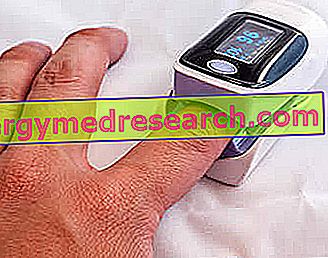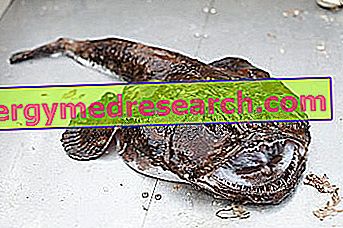Generality
Pulse oximetry is a particular method, indirect and non-invasive, which allows the measurement of oxygen saturation in the patient's blood ; more in detail, this examination allows to determine the oxygen saturation of the hemoglobin present in the arterial blood (often indicated with the abbreviation " SpO2 ").

In addition to data related to oxygen saturation in the blood, pulse oximetry is able to provide indications about other vital parameters of the patient, such as heart rate, plethysmographic curve and perfusion index.
Pulse oximetry can be practiced anywhere, both in hospitals, on rescue vehicles (ambulances, etc.), as well as at home. In fact, being a non-invasive and fully automated method, pulse oximetry can be performed by anyone and not necessarily by specialized healthcare personnel.
Pulse oximeter
As mentioned, to perform pulse oximetry it is necessary to use a special instrument: the pulse oximeter.
This instrument consists of a part dedicated to the detection and measurement of oxygen saturation in the blood, and a part used for the calculation and visualization of the result.
The part of the instrument responsible for carrying out the SpO2 measurement (ie, the pulse oximeter probe) can be described as a sort of pincer that, normally, is positioned straddling a finger, so that the two portions that make it up they are in contact with one of the patient's fingertips and the other with the nail of the same. Alternatively, the pulse oximeter can also be placed on the earlobe.
Generally, the probe is connected by a wire to the calculation and display unit of the collected data.
Principle of operation
The operating principle on which the pulse oximetry method is based is spectrophotometry . In fact, the pulse oximeter is nothing more than a small spectrophotometer in which the probe is equipped with a source - positioned on one of the arms of the clamp - which emits a light radiation at specific wavelengths (in this case, the light radiations emitted are found in the field of red and infrared, therefore at wavelengths, respectively, of 660 nm and 940 nm).
The beams of red and infrared light pass the finger, passing through all the fabrics and structures that compose it, up to the detector placed at the other end of the clamp. During this step, the light beams are absorbed by the hemoglobin bound to oxygen (oxyhemoglobin or HbO2) and by unbound hemoglobin (Hb). More in detail, oxyhemoglobin absorbs above all in infrared light, while unbound hemoglobin absorbs mainly in red light.
The pulse oximeter is able to calculate oxygen saturation precisely by exploiting this difference in the ability of the two different forms of hemoglobin to absorb red or infrared light.
Precisely because of the operating principle on which pulse oximetry is based, it is very important that the pulse oximeter probe is placed on an area where there is a superficial circulation and in an area that allows light radiations to reach the pulse oximeter detector positioned on the arm of the clamp opposite to the one in which there is the source that generates the light beams.
Saturation values
The pulse oximeter provides the oxygen saturation values as a percentage of hemoglobin linked to the latter:
- Values between 95% and 100% are generally considered normal; although a 100% oxygen saturation value may indicate the presence of hyperventilation.
- Values between 90% and 95%, on the other hand, are associated with a live hypo-oxygenation.
- Finally, values lower than 90% indicate the presence of hypoxemia for which it will be necessary to undergo more in-depth analyzes such as blood gas analysis.
Limits and Wrong Detections
Although pulse oximetry is a widely used method, it still has limitations and does not allow a correct detection of oxygen saturation if the patient is in certain conditions, pathological or not.
In this regard, we recall:
- Vasoconstriction . If the patient has peripheral vasoconstriction, the flow of transported blood may be reduced, as a result the pulse oximeter may perform incorrect measurements.
- Anemias . If the patient suffers from severe anemia, the pulse oximeter may indicate high saturation values even when the amount of oxygen in the blood is insufficient.
- Patient movement . The patient's movements, whether they are voluntary or involuntary, can alter the results of pulse oximetry.
- Methylene blue. The presence of methylene blue in the bloodstream can alter the absorption of light radiations emitted by the pulse oximeter, leading to the production and reading of incorrect data.
- Presence of colored enamel on the patient's nails - in particular, black, blue or green enamel - which can interfere with the reading of the data by the pulse oximeter detector, similarly to what happens in the case mentioned above.
Finally, it should be noted that pulse oximetry is able to determine the percentage of bound hemoglobin, but does not discriminate with which type of gas it is bound.
Under normal conditions the hemoglobin binds to oxygen, therefore, when pulse oximetry is performed it is assumed that the bound hemoglobin is oxyhemoglobin, therefore it transports oxygen.
However, there are situations in which hemoglobin also binds to another type of gas: carbon monoxide (CO), giving rise to a complex called carboxyhemoglobin (COHb). This is what happens, for example, in the case of carbon monoxide intoxications, in which this insidious gas displaces the binding of hemoglobin with oxygen, preventing it from transporting and releasing oxygen to the various tissues of the body.
During a carbon monoxide poisoning, the pulse oximetry performed with the pulse oximeter described in this article is not able to discriminate between oxygen-bound hemoglobin and carboxy-hemoglobin, and saturation values could therefore appear normal, even if in fact l circulating oxygen is not sufficient to support all the functions of the body.
However, there have been and are still developing particular pulse oximeters, more complex, which seem to be able to accurately detect the presence of oxyhemoglobin and carboxyhemoglobin in the patient's blood.



